A Recursive Truncated Taylor Expansion Downward Continuation Method for Geomagnetic Field
Abstract
1. Introduction
2. Recursive Truncated Taylor Expansion Downward Continuation
2.1. Basic Theory
2.2. Proposed Method
- (a)
- The geomagnetic space is constructed by multiple vertical lines. Each line’s magnetic field values form a function , with altitude z as the independent variable and magnetic field u as the dependent variable. This function can be expanded using a Taylor series as in Equation (5).
- (b)
- As upward continuation is a well-posed problem, use Equation (3) to perform spectral upward continuation of the known observation plane to supply data on vertical lines. Downward continuation is transformed into a process of downward extrapolation of the vertical magnetic field function based on the known values on the vertical lines.
- (c)
- The values of the each order of derivatives on every vertical line can be calculated using Equation (8). The initial truncated order t of derivatives is set to .
- (d)
- Using Equation (10), each order derivative terms obtained are used for the downward continuation of magnetic field by small step .
- (e)
- The downward continuation geomagnetic plane then is continued upward back to the observation plane for comparison. The truncated order t and the layer number n of the supplementary data can be optimized though repeating the step (b)–(e).
- (f)
- The optimal downward continuation plane by small step is seen as the new observation plane . And the downward continuation step (b)–(f) is implemented again until to the target plane.
3. Experimental Verification
3.1. Simulation Geomagnetic Data Verification
3.2. Measured Geomagnetic Data Verification
4. Discussion
5. Conclusions
Author Contributions
Funding
Institutional Review Board Statement
Informed Consent Statement
Data Availability Statement
Conflicts of Interest
Abbreviations
| RTTE | Recursive Truncated Taylor Expansion |
| ITRDC | Iterative Tikhonov Regularization Downward Continuation |
| TTSIDC | Truncated Taylor Series Iterative Downward Continuation |
References
- Goldenberg, F. Geomagnetic Navigation beyond the Magnetic Compass. In Proceedings of the 2006 IEEE/ION Position, Location, and Navigation Symposium, Coronado, CA, USA, 25–27 April 2006; pp. 684–694. [Google Scholar]
- Wang, Z.; Zhang, Q.; Chen, D.; Liu, Z.; Pan, M.; Hu, J.; Chen, Z.; Xu, Y.; Wang, Z.; Ren, X. A New Potential-Field Downward Continuation Iteration Method Based on Adaptive Filtering. IEEE Trans. Geosci. Remote Sens. 2022, 60, 5906011. [Google Scholar] [CrossRef]
- Wang, Q.; Zheng, C.; Wu, P.; Wang, X. Geomagnetic/Inertial Navigation Integrated Matching Navigation Method. Heliyon 2022, 8, e11249. [Google Scholar] [CrossRef]
- Li, Y.; Devriese, S.G.R.; Krahenbuhl, R.A.; Davis, K. Enhancement of Magnetic Data by Stable Downward Continuation for UXO Application. IEEE Trans. Geosci. Remote Sens. 2013, 51, 3605–3614. [Google Scholar] [CrossRef]
- Chen, L.; Cao, J.; Wu, M. Field Continuation Spatial Domain Algorithm Research for Geomagnetic Navigation; National Defense Industry Press: Beijing, China, 2015. [Google Scholar]
- Dufour, H.M. Potential Fields and Their Transformations in Applied Geophysics. J. Geod. 1976, 50, I. [Google Scholar] [CrossRef]
- Dean, W.C. Frequency Analysis for Gravity and Magnetic Interpretation. Geophysics 1958, 23, 97–127. [Google Scholar] [CrossRef]
- Zhou, W.; Zhang, C.; Tang, H.; Li, Q.; Tang, S. Iterative Imaging Method Based on Tikhonov Regularized Downward Continuation and Its Unmanned Aerial Vehicle Aeromagnetic Application: A Case Study from a Sijiaying Iron Deposit in Eastern Hebei Province, China. Geophysics 2023, 88, B343–B354. [Google Scholar] [CrossRef]
- Fedi, M.; Florio, G. A Stable Downward Continuation by Using the ISVD Method. Geophys. J. Int. 2002, 151, 146–156. [Google Scholar] [CrossRef]
- Tai, Z.; Zhang, F.; Zhang, F.; Hao, M. Approximate Iterative Operator Method for Potential-Field Downward Continuation. J. Appl. Geophys. 2016, 128, 31–40. [Google Scholar] [CrossRef]
- Chen, L.; Xu, S. The Iterative Least Square Method for Downward Continuation of Potential Fields. Chin. J. Geophys. 2011, 26, 894–901. [Google Scholar]
- Wang, B.; Hu, K.; Wang, Z. Advances in Research in Landweber Iterate Method for Inverse Problems and Its Application. Appl. Res. Comput. 2013, 30, 2583–2586. [Google Scholar]
- Li, H.; Zhao, B.; Zhang, H. An Iterative Tikhonov Regularization Downward Continuation of Magnetic Anomaly. J. Appl. Geophys. 2024, 223, 105354. [Google Scholar] [CrossRef]
- Chen, M.; Yang, W. An Enhancing Precision Method for Downward Continuation of Gravity Anomalies. J. Appl. Geophys. 2022, 204, 104753. [Google Scholar] [CrossRef]
- Zhang, C.; Qin, P.; Lü, Q.; Zhou, W.; Yan, J. Two New Methods Based on Implicit Expressions and Corresponding Predictor-Correctors for Gravity Anomaly Downward Continuation and Their Comparison. Remote Sens. 2023, 15, 2698. [Google Scholar] [CrossRef]
- Fedi, M.; Florio, G. Detection of Potential Fields Source Boundaries by Enhanced Horizontal Derivative Method. Geophys. Prospect. 2001, 49, 40–58. [Google Scholar] [CrossRef]
- Zhang, H.; Ravat, D.; Hu, X. An Improved and Stable Downward Continuation of Potential Field Data: The Truncated Taylor Series Iterative Downward Continuation Method. Geophysics 2013, 78, J75–J86. [Google Scholar] [CrossRef]
- Gang, Y.; Lin, Z. An Improved Stable Downward Continuation of Potential Fields Using a Truncated Taylor Series and Regularized Vertical Derivatives Method. J. Geophys. Eng. 2018, 15, 2001–2008. [Google Scholar] [CrossRef]
- Zhang, C.; Lü, Q.; Yan, J.; Qi, G. Numerical Solutions of the Mean-Value Theorem: New Methods for Downward Continuation of Potential Fields. Geophys. Res. Lett. 2018, 45, 3461–3470. [Google Scholar] [CrossRef]
- Wang, J.; Meng, X.; Zhou, Z. A Constrained Scheme for High Precision Downward Continuation of Potential Field Data. Pure Appl. Geophys. 2018, 175, 3511–3523. [Google Scholar] [CrossRef]
- Green, R. Potential Theory in Gravity and Magnetic Applications. J. Appl. Geophys. 1996, 36, 155–156. [Google Scholar] [CrossRef]
- Guo, Z.; Tao, C. Potential Field Continuation in Spatial Domain: A New Kernel Function and Its Numerical Scheme. Comput. Geosci. 2020, 136, 104405. [Google Scholar] [CrossRef]
- Revil, A.; Qi, Y.; Ghorbani, A.; Gresse, M.; Thomas, D.M. Induced Polarization of Volcanic Rocks. 5. Imaging the Temperature Field of Shield Volcanoes. Geophys. J. Int. 2021, 225, 1492–1509. [Google Scholar] [CrossRef]
- Coyle, M.; Oneschuk, D. Residual Total Magnetic Field, Kluane Lake West Aeromagnetic Survey, Yuklon, NTS 115-G/6 and Parts of 115-G/5 and 7; Natural Resources Canada: Ottawa, ON, Canada, 2015; p. 7913. [Google Scholar]
- Chen, L.; Cao, J.; Wu, M.; Lü, Y. Research on Spatial Domain Numerical Methods for Potential Field Continuation in Geomagnetic Navigation; National Defense Industry Press: Beijing, China, 2015. [Google Scholar]
- Kluane Lake West Aeromagnetic Survey. Residual Total Magnetic Field, NTS 115G/12 and Parts of NTS 115G/11, 13, 14 and NTS 115F/9 and 16, Yukon|Government of Yukon. Available online: https://open.canada.ca/data/en/dataset/cf83cbc0-ea19-291f-cbfa-fe11651d1c6e (accessed on 13 May 2025).
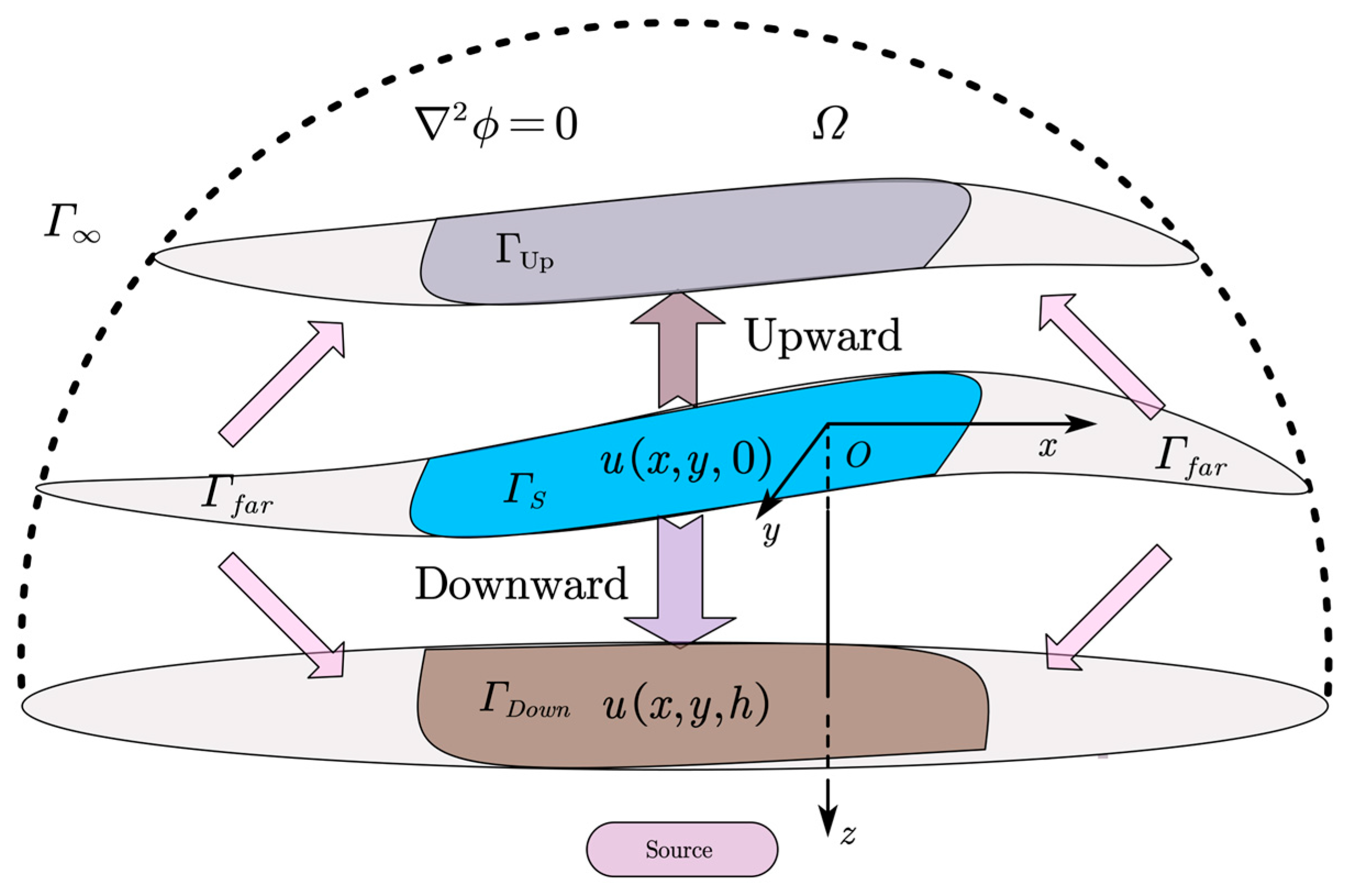
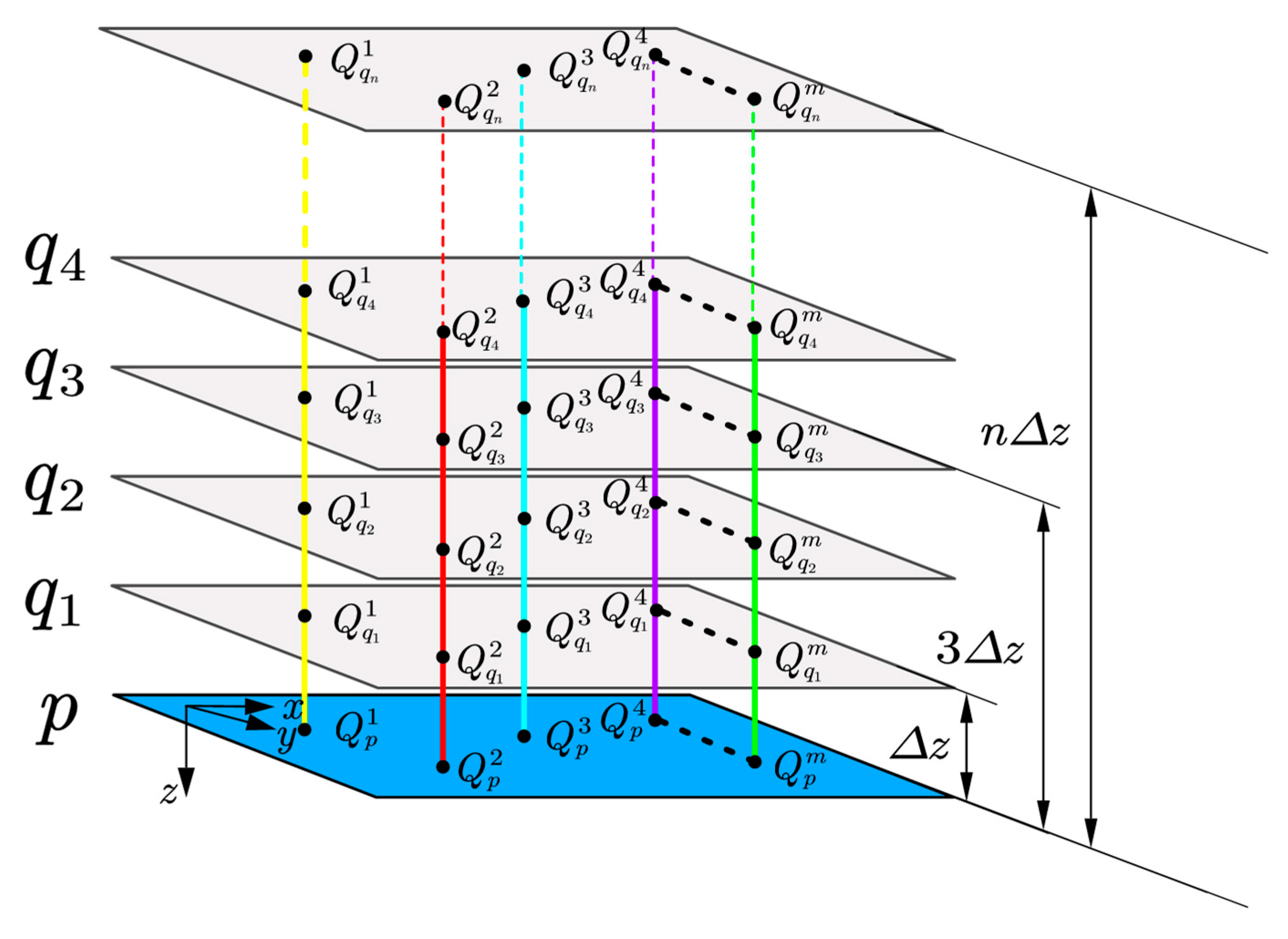
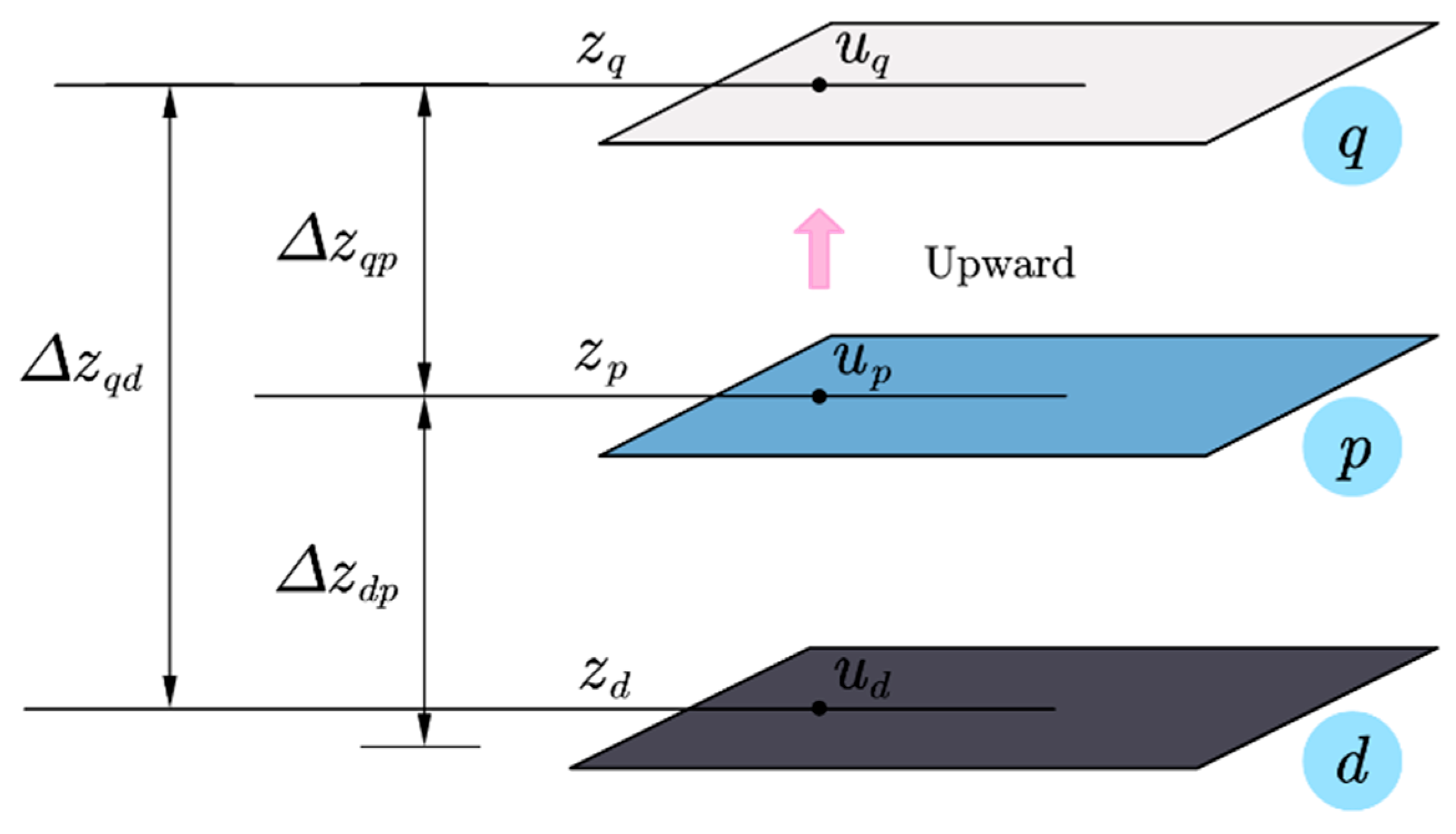
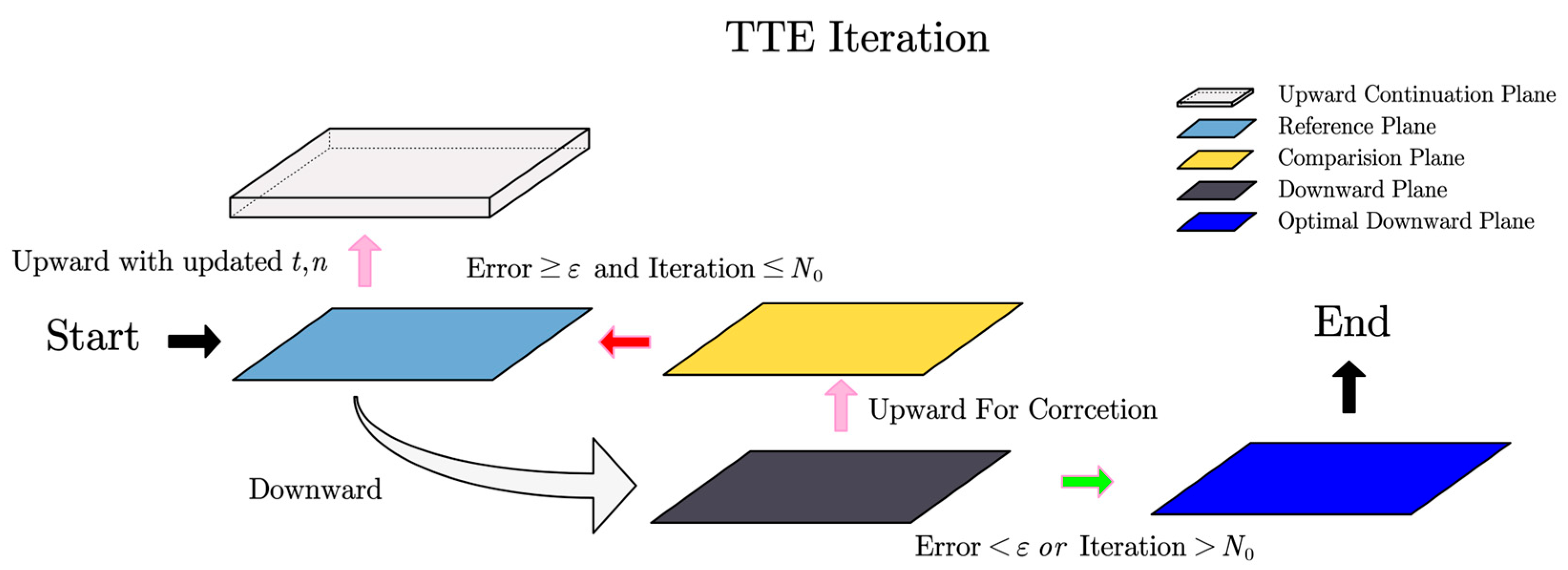

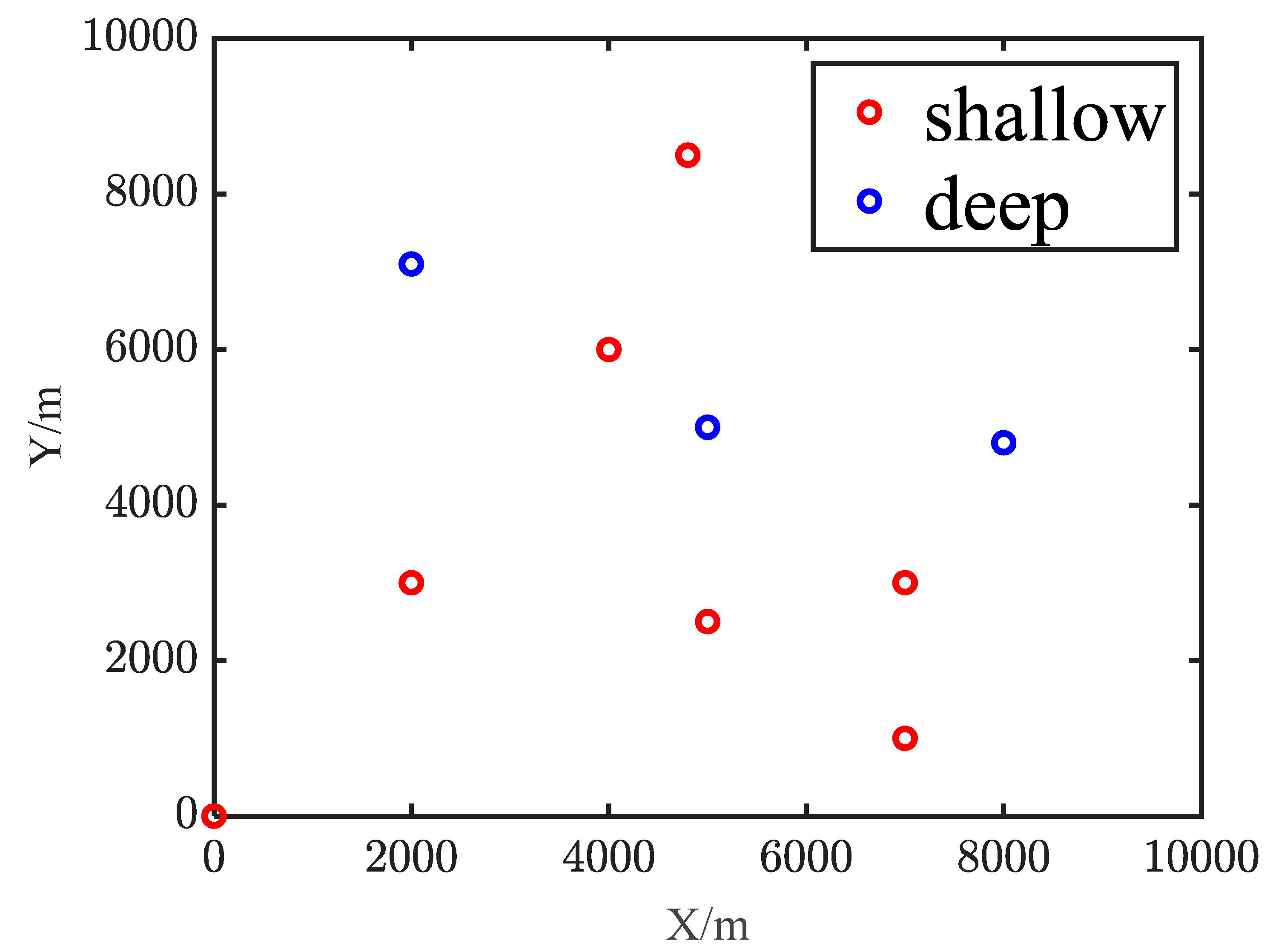




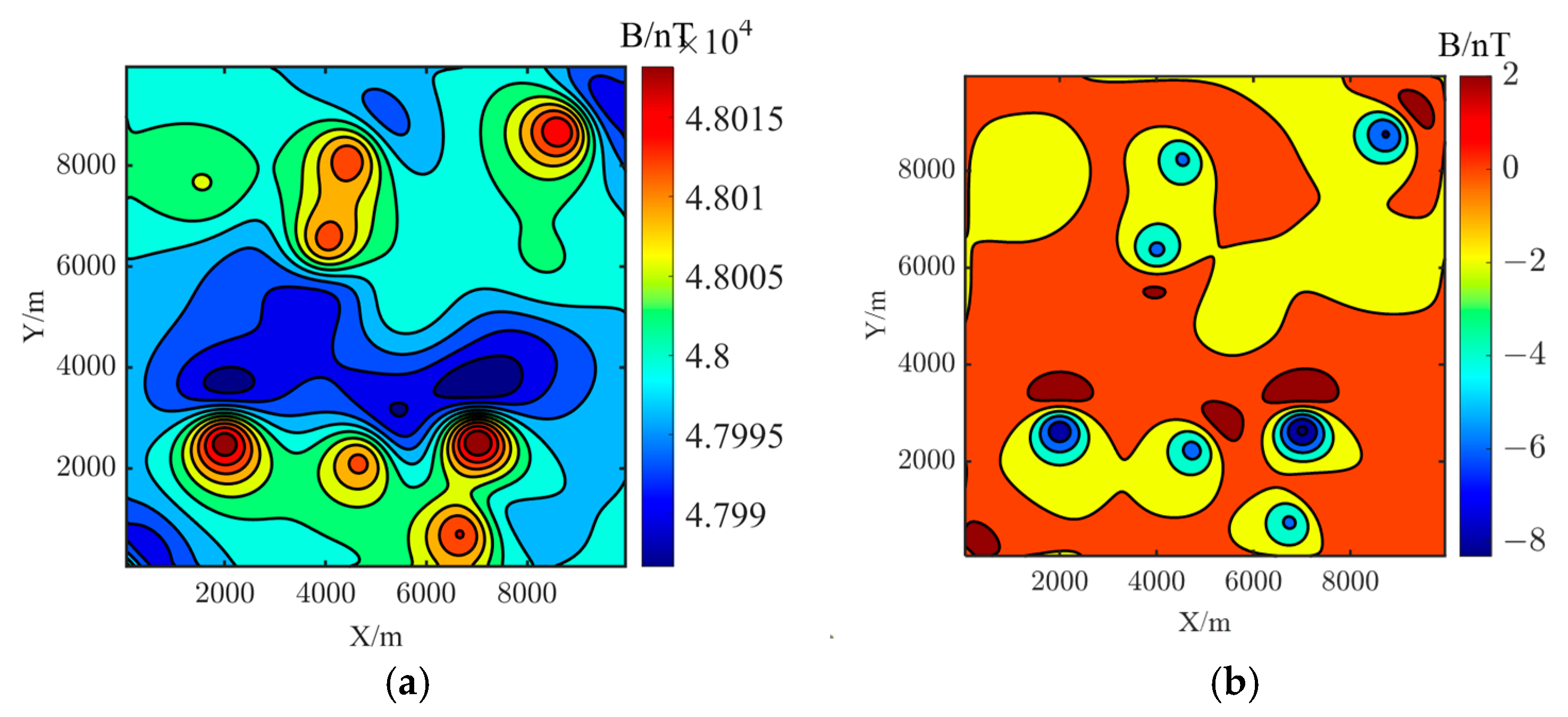


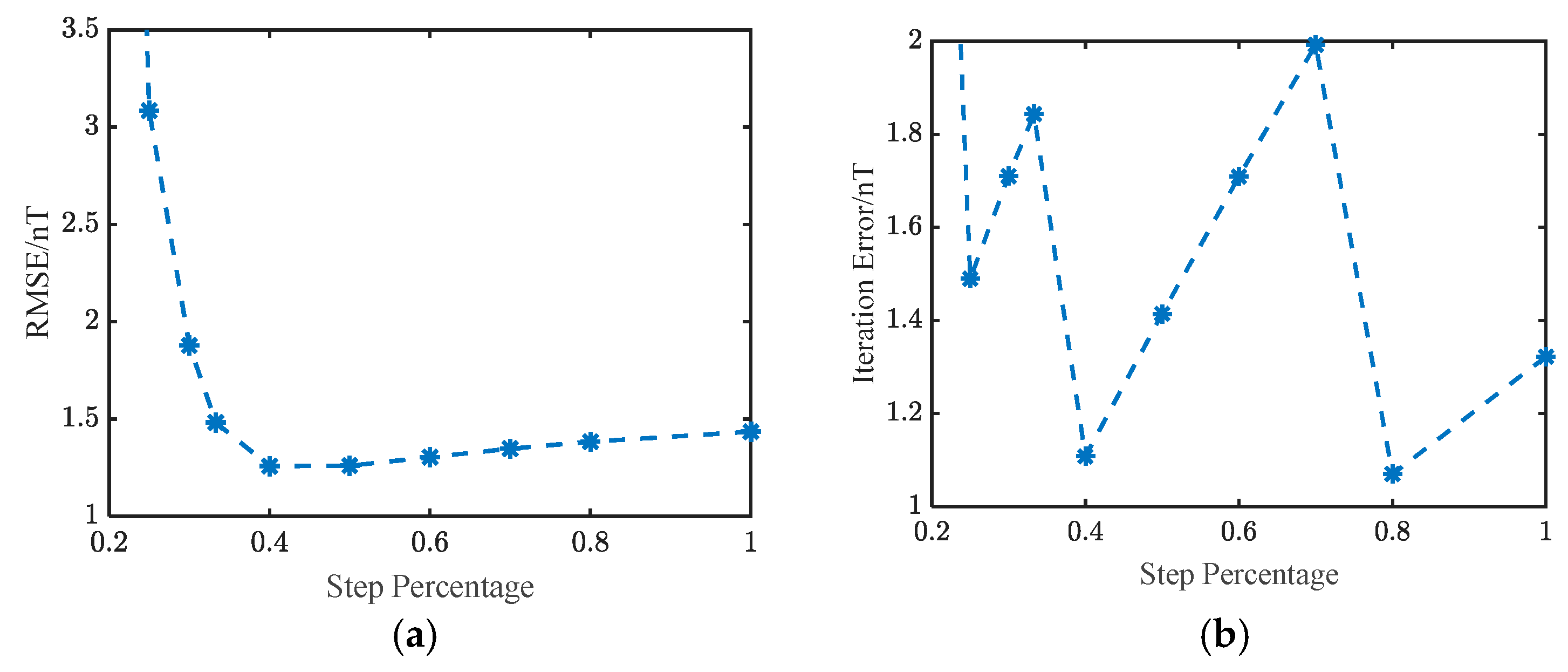
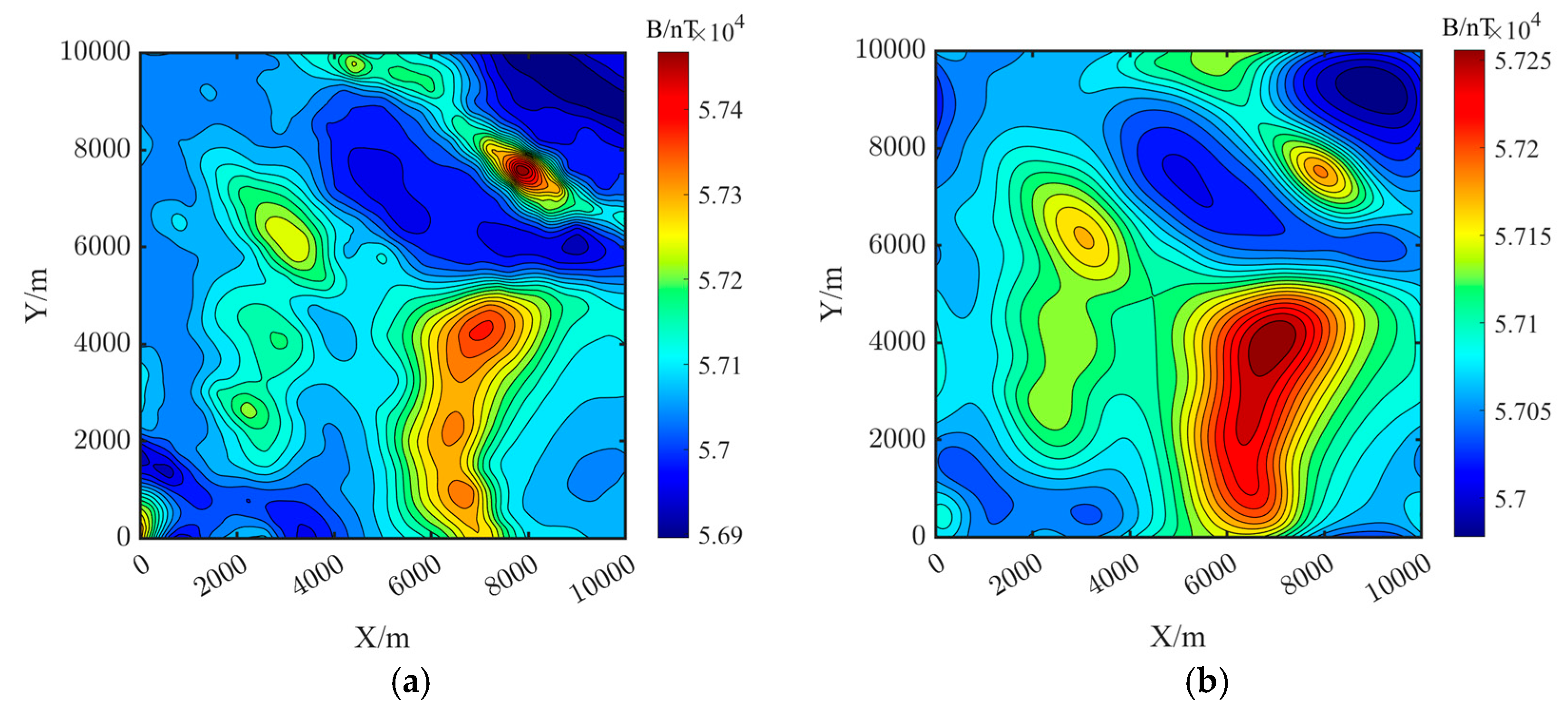
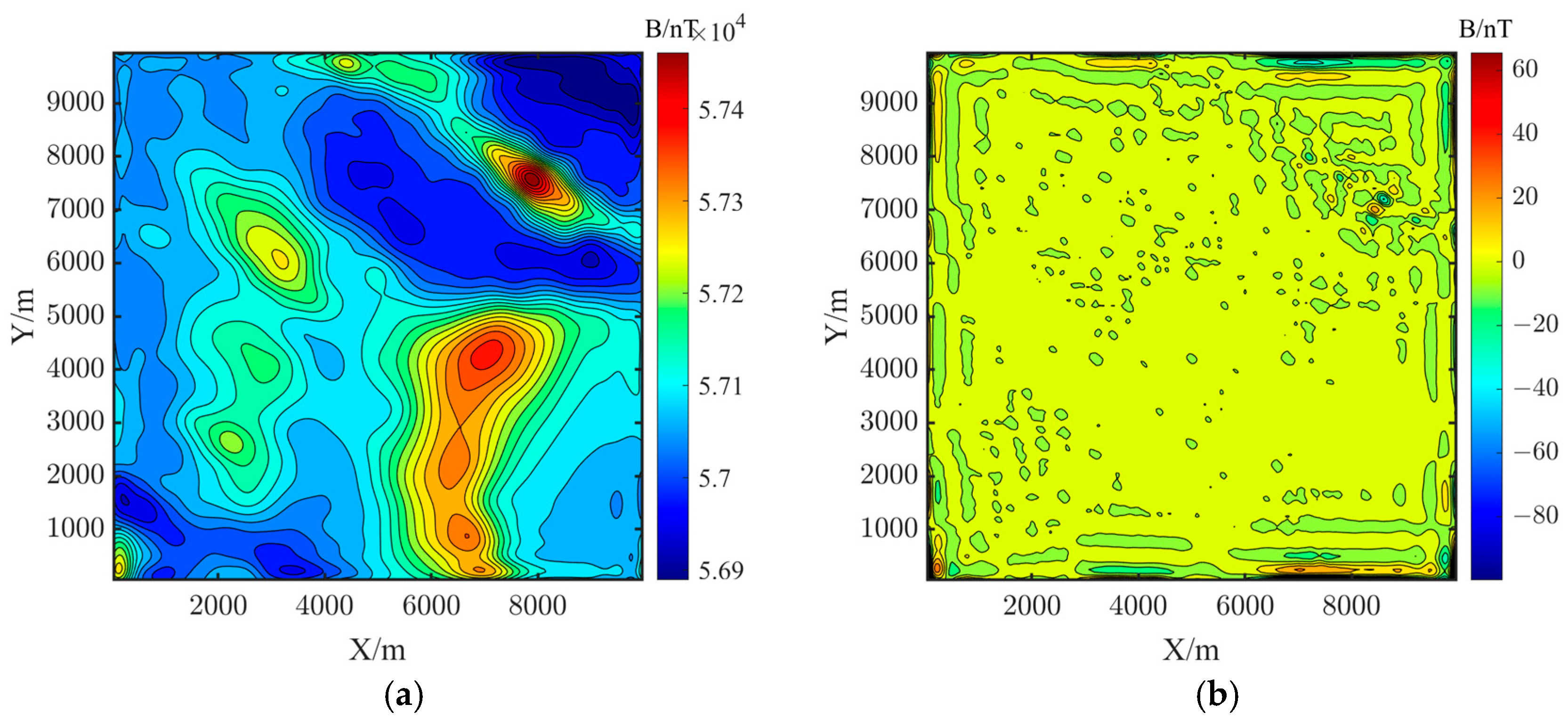
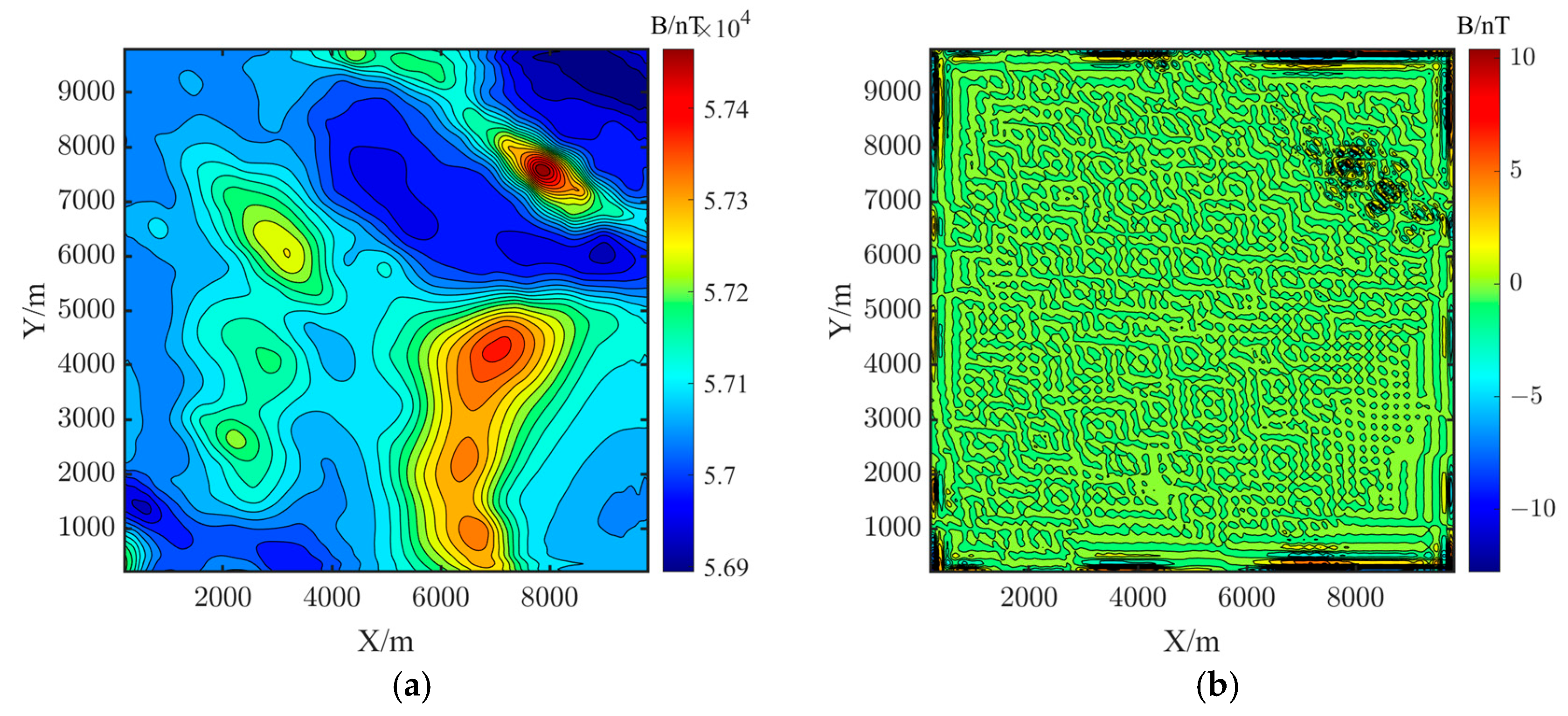

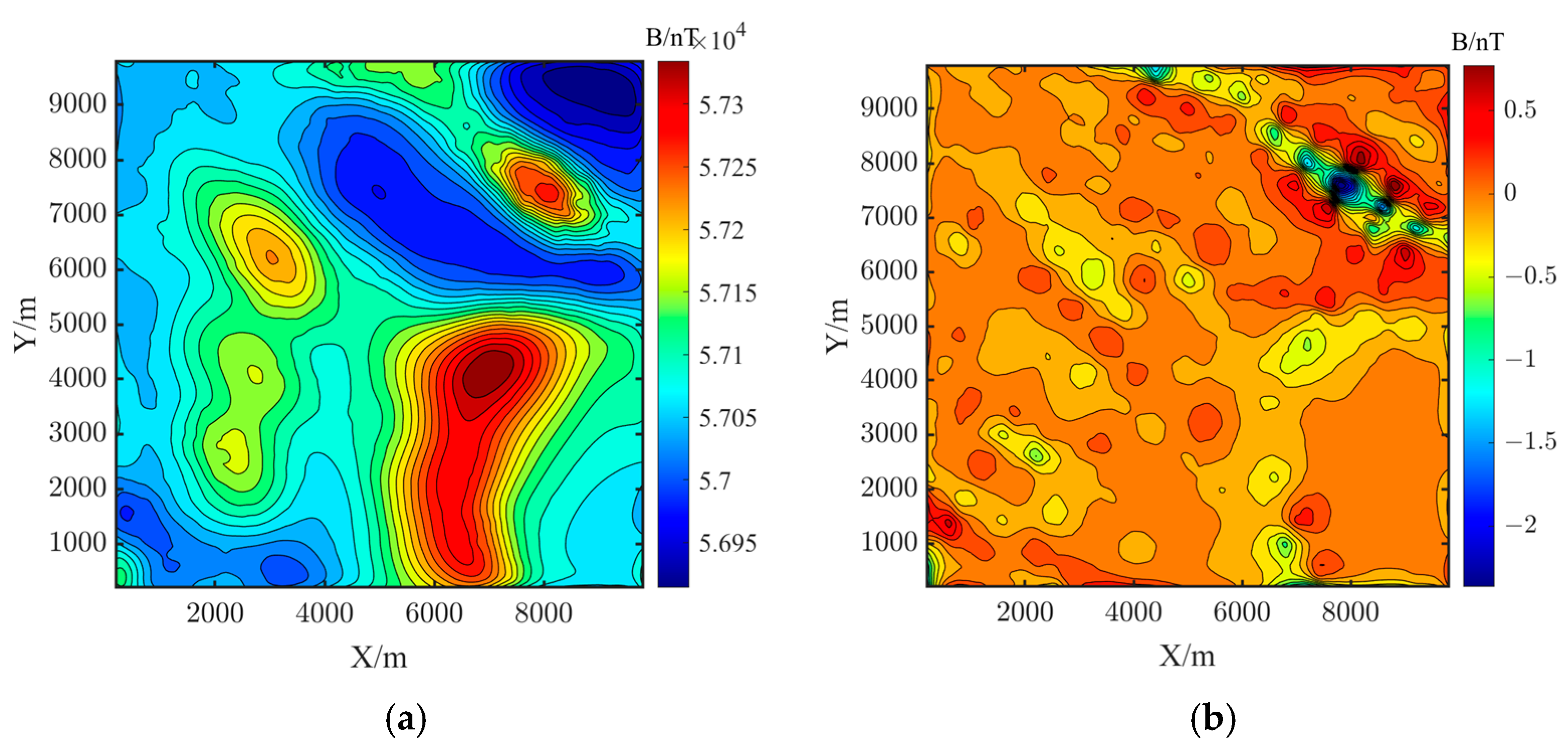
| Number | Location | Sphere Radius/m | Magnetic Susceptibility/A/m | ||
|---|---|---|---|---|---|
| x/m | y/m | z/m | |||
| 1 | 0 | 0 | −200 | 90 | 100 |
| 2 | 2000 | 3000 | −200 | 95 | 100 |
| 3 | 4800 | 8500 | −200 | 80 | 100 |
| 4 | 7000 | 3000 | −200 | 100 | 100 |
| 5 | 4000 | 6000 | −200 | 80 | 100 |
| 6 | 5000 | 2500 | −200 | 83 | 100 |
| 7 | 7000 | 1000 | −200 | 80 | 100 |
| 8 | 9000 | 9000 | −200 | 90 | 100 |
| 9 | 5000 | 5000 | −500 | 100 | 100 |
| 10 | 8000 | 4800 | −500 | 100 | 100 |
| 11 | 2000 | 7100 | −500 | 100 | 70 |
| MAE/nT | RMSE/nT | |
|---|---|---|
| Landweber Iteration | 1.7474 | 7.3740 |
| ITRDC | 1.4534 | 3.3050 |
| TTSIDC | 0.7717 | 1.2252 |
| RTTE | 0.3814 | 0.7192 |
| MAE/nT | RMSE/nT | |
|---|---|---|
| Landweber Iteration | 1.9419 | 7.4978 |
| ITRDC | 1.2399 | 5.8319 |
| TTSIDC | 3.0562 | 4.1886 |
| RTTE | 0.1878 | 0.3184 |
Disclaimer/Publisher’s Note: The statements, opinions and data contained in all publications are solely those of the individual author(s) and contributor(s) and not of MDPI and/or the editor(s). MDPI and/or the editor(s) disclaim responsibility for any injury to people or property resulting from any ideas, methods, instructions or products referred to in the content. |
© 2025 by the authors. Licensee MDPI, Basel, Switzerland. This article is an open access article distributed under the terms and conditions of the Creative Commons Attribution (CC BY) license (https://creativecommons.org/licenses/by/4.0/).
Share and Cite
Wan, K.; Li, H.; Liu, X.; Liu, Z.; Xu, Y.; Xiang, Y.; Ding, Z.; Dai, W.; He, X.; Zhang, Q. A Recursive Truncated Taylor Expansion Downward Continuation Method for Geomagnetic Field. Appl. Sci. 2025, 15, 8913. https://doi.org/10.3390/app15168913
Wan K, Li H, Liu X, Liu Z, Xu Y, Xiang Y, Ding Z, Dai W, He X, Zhang Q. A Recursive Truncated Taylor Expansion Downward Continuation Method for Geomagnetic Field. Applied Sciences. 2025; 15(16):8913. https://doi.org/10.3390/app15168913
Chicago/Turabian StyleWan, Ke, Haibin Li, Xu Liu, Zhongyan Liu, Yujing Xu, Yujie Xiang, Zengquan Ding, Weiji Dai, Xinrong He, and Qi Zhang. 2025. "A Recursive Truncated Taylor Expansion Downward Continuation Method for Geomagnetic Field" Applied Sciences 15, no. 16: 8913. https://doi.org/10.3390/app15168913
APA StyleWan, K., Li, H., Liu, X., Liu, Z., Xu, Y., Xiang, Y., Ding, Z., Dai, W., He, X., & Zhang, Q. (2025). A Recursive Truncated Taylor Expansion Downward Continuation Method for Geomagnetic Field. Applied Sciences, 15(16), 8913. https://doi.org/10.3390/app15168913






